Brain atlas reveals differential effects of aging and Alzheimer’s disease
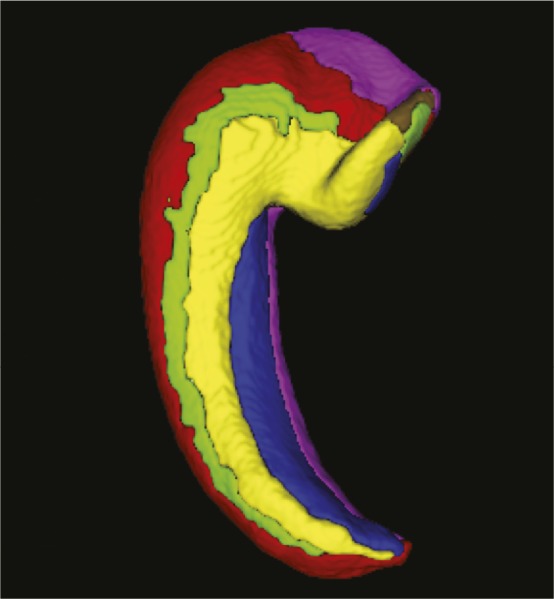
3D model of average anatomy of the hippocampus. Each color represents a different subfield.
Existing data on the anatomical variability and 3D organization of the human hippocampus—as well as the effects of age and disease on this brain region—are limited and inconclusive. To build a 3D atlas of the hippocampus, Daniel Adler et al. (pp. 4252–4257) combined high-resolution ex vivo MRI scans of 31 postmortem brain samples from 25 individuals, ages 58 to 84 years, including patients diagnosed with Alzheimer’s disease (AD) or other forms of dementia as well as controls without dementia. Through serial histological imaging of nine samples, the authors labeled hippocampal subfields within the atlas based on cellular architecture. The labeling enabled the authors to evaluate the effects of AD and aging on the volume, thickness, and other anatomical features of the hippocampus. In the AD samples, all hippocampal subfields showed a decrease in volume and average thickness; compared with controls without dementia, the largest decreases in hippocampal volume observed in AD were 46.0% and 44.9% of the cornu ammonis 1 and stratum radiatum lacunosum moleculare subfields, respectively. In contrast, an age-related decrease in hippocampal volume of 2% per year was observed in controls without dementia, with pronounced loss in the dentate gyrus. Thus, the authors suggest, AD and aging might affect the hippocampus differently. According to the authors, the atlas provides a valuable reference for future research on hippocampal changes in aging and neurodegenerative disease. — T.G.
Diabetes drug prevents nicotine withdrawal anxiety in mice
Cigarette smoking is estimated to account for more than 500,000 deaths each year in the United States. Current treatments that target nicotine withdrawal symptoms achieve a success rate of only 15%. Julia Brynildsen et al. (pp. 4282–4287) provide evidence in mice that anxiety-like behaviors induced by nicotine withdrawal can be reduced through activation of the AMP-activated protein kinase (AMPK) enzyme in the brain’s hippocampus. The authors administered nicotine to mice for 2 weeks using osmotic minipumps placed under the skin. Prior to nicotine withdrawal, the mice were injected with either saline as a control treatment or one of two AMPK activators—a molecule called AICAR or a clinically approved diabetes drug called metformin. In contrast to saline injections, treatment with the AMPK activators prevented withdrawal-induced anxiety-like behaviors. Specifically, mice that received AMPK activators buried fewer marbles in their cage bedding and waited less time before eating palatable food in a novel environment. Additional experiments revealed that metformin reduced withdrawal-induced anxiety by activating AMPK in the hippocampus. According to the authors, the preclinical efficacy of metformin in alleviating withdrawal symptoms, along with its safety profile for diabetes treatment, suggests that the drug may hold promise as a nicotine cessation therapy. — J.W.
Origins of fluted-point technology in Arctic North America
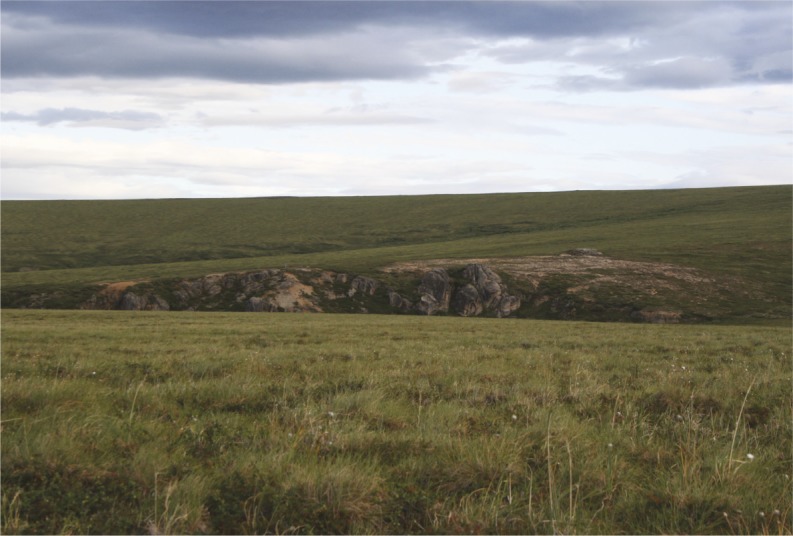
Bluffs and hilltops near Serpentine Hot Springs in Bering Land Bridge National Preserve.
The emergence and spread of fluted projectile points have been linked to the spread of humans in the Western Hemisphere. However, the cultural and evolutionary histories of fluted-point technology in Arctic North America, such as in the Ice-Free Corridor of western Canada and in eastern Beringia, remain unclear. Heather Smith and Ted Goebel (pp. 4116–4121) explored the evolutionary relationship among fluted-point variants from North America to help explain the origins and spread of fluted-point technology during the Late Pleistocene and early Holocene Epochs. The analysis included more than 200 fluted-point specimens from Alaska, the northern Yukon, the Ice-Free Corridor, the temperate Great Plains, the eastern United States, and Canada. The authors evaluated the fluted specimens using geometric morphometric shape analysis and patterns of technological characteristics that complement geographic locations of dated archaeological sites. The results revealed similarities in the morphologies and technologies of Clovis, Ice-Free Corridor, and northern fluted specimens, suggesting that fluting technology in the Arctic likely originated in areas of the Ice-Free Corridor, and ultimately, temperate North America. Additionally, the authors suggest that regional variations in fluted-point technology might be associated with the ecological settings in which humans used the technology. The findings might help unravel patterns of human dispersal in the Americas, according to the authors. — C.S.
Auditory motion parallax and discrimination of sound sources
Humans have difficulty estimating the distance of unknown sound sources. For vision, humans use motion parallax to help determine the depth of different objects, given that lateral head movements cause nearby objects to appear to move more than distant objects. Using psychophysical experiments, Daria Genzel et al. (pp. 4264–4269) demonstrate that humans can use auditory motion parallax to discriminate between two sound sources at different depths. In an experiment featuring real sound sources placed at different depths, the authors found that participants could distinguish a high-pitched sound source from a low-pitched sound source, performing better when allowed to move their heads laterally. In a second experiment using virtual sound sources, participants who actively moved their upper body could reliably distinguish a low-pitched sound source from a high-pitched sound source at different depths. The participants’ performance declined when they were passively moved by a motion platform or when the sound sources moved, even though the dynamic binaural cues elicited by all three types of motion are identical. When neither the sound sources nor the participants moved, none of the participants could distinguish between the depths of the two sound sources. According to the authors, humans can discriminate between sound sources at different distances by integrating self-motion with binaural auditory motion cues to exploit auditory motion parallax. — S.R.
Evolution of human locomotion
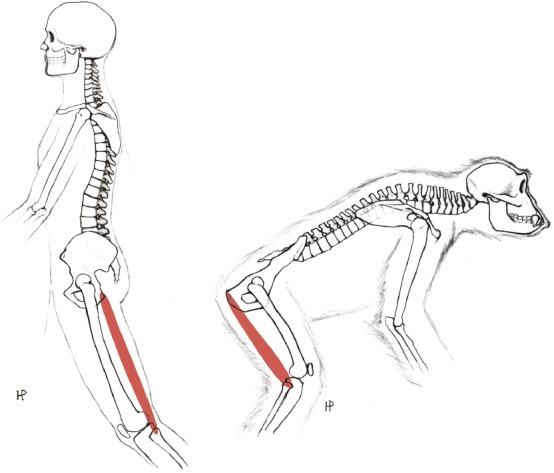
Evolved changes in pelvis shape allow hamstring muscles (red) to hyperextend the hip in humans, but not in apes.
Humans’ straight-legged walking gait provides substantially improved walking economy, or distance traveled per unit of energy consumed, compared with nonhuman apes. However, when and how human gait evolved remains unclear. Researchers have assumed that adaptations for improved walking economy require a corresponding reduction in climbing ability, but few studies have tested this hypothesis. Elaine Kozma et al. (pp. 4134–4139) compared locomotor mechanics and pelvic morphology in humans and apes to determine how the force generated at the knee per unit of hamstring tension varies with hip extension. Great apes had a greater maximum force generation than humans, resulting in enhanced climbing ability. However, ape pelvic orientation limited the hip extension angle to 160° or less, whereas humans could extend their hips beyond 180°, as required for upright walking. The authors used the results to estimate the locomotor capabilities of the early hominins Ardipithecus ramidus, Australopithecus afarensis, and Australopithecus africanus based on pelvic morphology. All three early hominins had an estimated range of motion similar to that of humans. However, Ardipithecus also had an estimated maximum force generation similar to that of apes. Ardipithecus thus appears to have developed improved walking economy, compared with apes, without sacrificing climbing ability, according to the authors. — B.D.
Everolimus treatment for lamin disorders
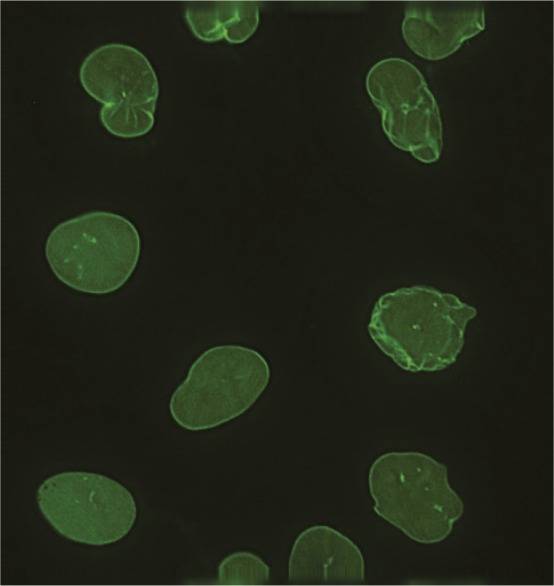
Abnormally shaped nuclei of fibroblasts from an HGPS patient (lamin A/C in green).
Hutchinson-Gilford progeria syndrome (HGPS) is a rare and potentially fatal disease marked by premature aging, hearing loss, impaired mobility, and accelerated atherosclerosis, among other symptoms. HGPS is caused by the buildup of progerin, a toxic form of lamin A, a protein found in cells’ nuclear scaffold. Previous studies have found that treatment with everolimus, a rapamycin analog, ameliorates defects in cells from HGPS patients. Amanda DuBose et al. (pp. 4206–4211) tested whether everolimus similarly attenuates cellular defects in other lamin-related disorders. Compared with mock treatment, treatment with everolimus increased cell proliferation and slowed senescence in six cell lines derived from patients with different lamin disorders, namely atypical Werner syndrome, Emery-Dreifuss muscular dystrophy, and atypical HGPS. In three of four cell lines with excessive nuclear blebbing, or abnormal nuclear shape, everolimus reduced blebbing and improved nuclear appearance, compared with controls. Unlike rapamycin, everolimus is well-tolerated and has a proven safety record for use in children. Further, the drug is approved for transplant rejection and cancer treatment, and ongoing clinical trials are testing its efficacy for HGPS treatment. Hence, the authors suggest, everolimus might represent a drug candidate worthy of clinical trials for other lamin-related disorders marked by the buildup of toxic proteins. — P.N.
Human inner ear morphology and dispersal from Africa
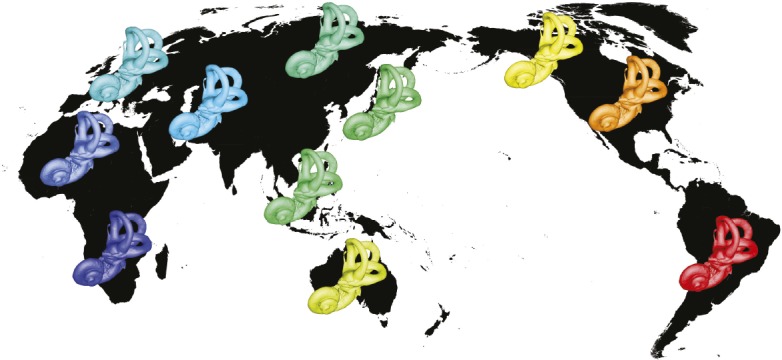
The inner ear of modern humans shows subtle shape differences between populations tracking human dispersal from Africa with the colors symbolizing dispersal distance from sub-Saharan Africa based on agent-based dispersal simulations (dark blue: 0 km; light blue: 10,000 km; cyan: 20,000 km; green: 25,000 km; yellow: 30,000 km; orange: 35,000 km; red: 40,000 km).
Skeletal features, such as cranial and pelvic morphologies, can lend insight into human dispersal from Africa. However, local adaptations, phenotypic plasticity, and postmortem damage to skeletal remains can obscure skeletal-derived patterns of human dispersal from Africa. Marcia Ponce de León et al. (pp. 4128–4133) evaluated the potential of the cavity system of the inner ear, which is fully formed at birth and typically well-preserved, to serve as an information source on the global dispersal of modern humans from Africa. The authors compared worldwide variation in the inner ear’s cavity system, also known as the bony labyrinth, with genetic markers, such as single-nucleotide polymorphisms, that have been previously reported to reflect human dispersal patterns from Africa. Computed tomography was used to obtain high-resolution 3D data of bony labyrinths from 221 skeletal specimens representative of 19 historical and three prehistoric populations worldwide. Using statistical modeling, the authors found that labyrinth morphology correlated with dispersal distance from Africa, indicating that labyrinth morphology corresponds with dispersal patterns based on genetic markers. According to the authors, the findings might open avenues for individual-based genotype and phenotype comparisons in past and present human populations. — C.S.


